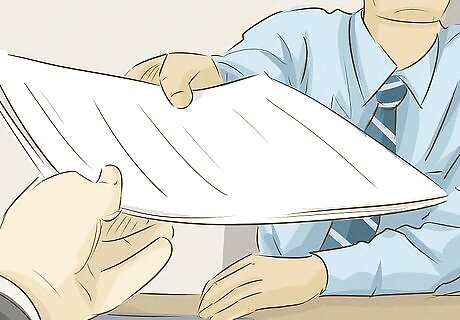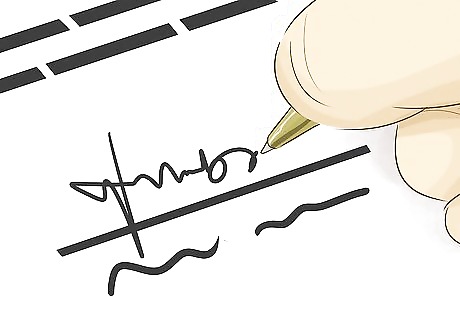
views
X
Research source
Responding to the Complaint

Read the complaint and summons. The summons gives you information about the person suing you and when you must respond to the suit or appear in court, while the complaint provides you with details about the person's allegations against you. On the summons you'll find the name and contact information of the person suing you (or his or her attorney). You'll need this information when you've filed your answer so you can have a copy served. Take note of whether the person suing you is a private individual or another company in competition with you. Under federal and some state laws, competitors can sue you for false advertising if their businesses are harmed as a result of your deceptive advertising practices. The summons also will let you know when you must file a response to the complaint. In most cases this deadline will be less than 30 days of the date you received the complaint, so mark it on your calendar. If you miss this deadline, the plaintiff may win by default. Check the court where the plaintiff filed his or her lawsuit. If it's far away from you, it may not have jurisdiction over you – but you must raise this issue in your first court filing or you'll lose the right to bring it up later. Depending on the nature of the advertisement, you may be sued in state or federal court. A single consumer might sue you in small claims for a refund on a product he or she bought in reliance on a deceptive ad, or a group of consumers may sue for a larger sum in state or federal civil court. You also want to look up the statute of limitations that applies to the plaintiff's claim. This law provides a deadline by which the plaintiff must file his or her lawsuit. A quick online search typically will reveal the statute of limitations for the lawsuit.

Consider consulting an attorney. If you are being sued for a significant amount of money, or if the plaintiff is represented by an attorney, you may want to hire an attorney with experience in advertising and media law to protect your interests. The type of attorney you choose will depend to some extent on who the plaintiff is. If you've been hit with a class action lawsuit, you will need to find an attorney with experience in class action defense. However, this experience isn't necessary if you've been sued by a competitor or single consumer. If you've been sued in small claims court, you typically won't need an attorney. However, some courts require a business to be represented by an attorney in small claims, so check with the court clerk where the lawsuit was filed if you are unsure.

Search for forms or templates. Most courts have fill-in-the-blank forms or templates available that you can use to format your answer. You also can call the clerk of the court where the plaintiff filed the lawsuit and ask for a form or a copy of an answer filed in another case that you can use as a guide to format your answer. Your answer should be typed on 8.5 x 11 paper with one-inch margins on all sides. These typically are the default settings on most word processing applications. At the top of your first page, you'll place the case's caption. You can copy the caption directly from the complaint. You should copy it exactly, even if your name is spelled incorrectly – this is how the court identifies the case and it should be identical on all documents.

Address each allegation in the complaint. Using the same paragraph numbers in the complaint, let the plaintiff and the court know whether you admit or deny each allegation. At all times, refer to yourself as "Defendant" and the person who sued you as "Plaintiff." Follow the same structure as the complaint, using numbered paragraphs. For each of the complaint's allegations, type the paragraph number and indicate whether you admit or deny the allegation. If you don't know anything about the allegation – a response common with allegations related specifically to the plaintiff – you also can respond "Defendant has insufficient information to either admit or deny the allegation." Courts treat that the same as a denial. Denying an allegation doesn't mean you're saying the allegation is untrue – it simply means you are insisting that the plaintiff prove it. The plaintiff generally has the burden of proof in civil cases, but if you admit an allegation the plaintiff is relieved of that burden. If you have any defenses, such as that the statute of limitations has passed, you should list these in numbered paragraphs after you've responded to the allegations in the complaint.

Sign your answer. Before you file your answer with the court it must be signed and dated. Make sure you review it before you print to catch any typos or other errors. You can use the "print preview" function to check your formatting and confirm that the pages line up correctly. Make at least two copies of your signed answer so you have one to deliver to the plaintiff and one for your own records. The clerk will keep the original's for the court.

File your answer. Take your original answer and your copies to the clerk of the court where the plaintiff filed his or her lawsuit. The clerk will stamp both your originals and your copies "filed," then return the copies to you. Typically you are responsible for having the copy delivered to the plaintiff, although in some courts the clerk will take care of it for you. The process of delivering court documents to the other party is called service. You must serve the papers in such a way that you have proof the other party received them. The easiest way to do this is to mail the documents using certified mail with returned receipt requested. Ask the clerk for the forms you need. You also can hire the sheriff's department or a private process-serving company to hand-deliver the documents to the plaintiff.
Crafting Your Defense Strategy

Research state and federal advertising law. Before you can fully analyze the plaintiff's complaint, you must have a general understanding of the kinds of claims prohibited in advertising. You can find legal resources by looking up your state's consumer protection agency online. There also is information about federal law at the Federal Trade Commission's website. Essentially, you should understand the line between making false or unsubstantiated claims and boasting about your product. For example, if you own a soul food restaurant in California, you can claim in advertisements that you have the best tasting soul food west of the Mississippi. However, saying eating your food makes people healthier or makes them live longer typically would violate the law.

Gather information. You will need documents and witnesses that support the truthfulness of your advertisements. Depending on the plaintiff's allegations, you may need records and other data outside the advertisement itself. For example, the plaintiff may allege that you advertised a sale but didn't have enough of the advertised product in stock to meet demand, and that when she came into the store she was offered a more expensive product instead. To prove that you did stock the product, you can produce purchase and sales records for that product. Keep in mind that consumer protection laws typically provide remedies for consumers even if your violation of the law was unintentional. If you created advertising with the belief that it was true, and it later turned out to be false, you may want to consider contacting the plaintiff with a settlement offer before the dispute becomes public knowledge.

Seek out expert witnesses. Some types of claims may require you to hire an expert to corroborate the claims made in your advertisements. For example, if you've made technical or scientific claims about something you sell, you may need a witness with knowledge in the field to study and make an assessment about the truthfulness of your claim. If you relied on scientific studies, you can use those resources as evidence, but you may want to attempt to contact the authors of the studies you used. However, keep in mind that what matters is the deceptive impression created by your ad – not the technical truthfulness of any of the specific facts or information you conveyed.

Participate in discovery. Through the discovery process, you and the plaintiff will exchange documents and information related to the case. You and the plaintiff can send each other written questions or requests to produce certain documents or other evidence you plan to use at trial. This written discovery must be answered under oath within a specific period of time outlined by the court. You also may have depositions, in which the parties or other witnesses are interviewed. The interview is transcribed by a court reporter so you have a written record to refer to later. If the plaintiff has filed his or her lawsuit in small claims court, there may not be any discovery allowed. In small claims courts that do allow discovery, it typically is an abbreviated process restricted to written discovery only.

Consider mediation. A neutral third-party mediator may be able to assist you and the plaintiff in coming to a mutually agreeable settlement. Mediation is less formal than a trial, and focuses on bringing the two parties together to compromise and resolve their dispute. What happens in mediation also is confidential, which can be a benefit to you as a business owner if you are trying to preserve your image and relationship with your customers. Settling the dispute on mutually agreeable terms can keep the situation from escalating and damaging your good will in the community. Some courts require you to attempt mediation before you are allowed to proceed to trial; in others mediation is optional. The clerk will have a list of mediators approved by the court that you can choose from.
Attending Your Trial

Organize your evidence for trial. You'll want to create notes or an outline of the key points of your defense along with the evidence you want to introduce in court. If you're presenting any documents, such as a copy of your advertisement, as evidence, make sure you bring the original and at least two copies. That way you have one for the court, one for yourself, and one for the plaintiff. Meet with any witnesses you plan to call at least once before the trial and go over the questions you'll be asking them. You also may want to brainstorm questions the plaintiff might ask on cross-examination. If you're representing yourself, you may want to go to court before your trial date and observe the judge who will be presiding over your case. This gives you the opportunity to become more familiar with court procedures and have a better understanding of how the judge runs his or her courtroom. Make notes of the key points of your defense, but also take some blank paper and a pen or pencil so you can take notes during your trial.

Appear on your court date. To avoid missing your trial, arrive at the courthouse at least a half hour before the time on your summons, so you have time to pass through security and find the right courtroom. Check in the court lobby or on the court's website so you know what types of items are forbidden in the court house. If you have something you intend to use as evidence and it's on the list of forbidden items, you will need to get permission ahead of time. If the judge is hearing several cases on the same day, take a seat in the gallery until your case is called. When the judge calls the name of your case, stand. If he or she is ready to hear your case, you can proceed to the tables at the front of the courtroom.

Listen to the plaintiff's presentation. Courts typically give the plaintiff the opportunity to tell his or her side of the story first. Pay attention, and avoid interrupting or disrupting the plaintiff – even if he or she says something with which you disagree. Take notes so you can bring up the point later when it's your turn to speak. If the plaintiff calls any witnesses, you will have the opportunity to ask them questions as well. Be cautious during cross-examination, and avoid asking questions if you have no idea what the witness's answer will be.

Present your defense. After the plaintiff has finished, it will be your turn to introduce your own evidence and witnesses to show you are not liable for damages. If you call witnesses, the plaintiff also will have the opportunity to ask them questions. The judge typically will give you the opportunity to "redirect" the witness if you choose to do so after the plaintiff completes cross-examination. Use this opportunity as necessary to reinforce the reason you called the witness. Make your strongest point first, then proceed to the next strongest point, and so on. Don't worry about telling the story in chronological order if it doesn't benefit your defense to do so. Speak loudly and clearly, and stick to the facts.

Receive the judge's ruling. The judge may make a decision from the bench immediately after the conclusion of the trial, or may want to review the evidence in the case again before issuing an order. If you don't receive a ruling from the judge on the day of the trial, ask the clerk when to expect it. The clerk will be able to give you a time frame of when the order will be issued, and also whether you will be notified. If the judge rules against you, he or she may order you to pay monetary damages to the plaintiff, stop publishing the ads that were the subject of the lawsuit, or run corrective ads explaining that previous ads were deceptive.



















Comments
0 comment